» Available only in Dotypos FULL and higher. « |
|---|
Ingredient is a kind of product feature not stocked out of the warehouse, but only the product’s ingredients are. This lets you define at the point of sale of a product the exactly defined quantity of other items to be stocked out of the warehouse.
Examples of ingredients:
Create coffee, milk and coffee with milk products. When charging coffee with milk, the product itself will not be stocked out of the warehouse, but only the corresponding amount of its ingredients (coffee and milk). You can use ingredients when selling draft beverages or when you stock out 0.3 or 0.5 liter of another common product (barrel). You can also stock out from the warehouse various hair dressing preparations that consist of ingredients in an uneven proportion.
Warehouse ingredients can be set up either directly in the cash register or in Dotypos Cloud. The third option is to perform a batch import of ingredients. However you must have both product ingredients and products to be used as ingredients created in the cash register first. Then, use import to assign ingredients to individual products and to set up the quantity of ingredients that will be deducted during the sale.
In a simplified way, fill the import file with products to be deducted and also with products to be used as ingredients. You can define the deducted products and their ingredients using the product number, which can be found in the properties of each product in the Basic item. Then, in the import file you put this number into the appropriate column depending on whether it is a product that will be deducted or an item that will be used as ingredient.
|
To import ingredients, you may only use products and ingredients created in advance. The import of ingredients does not create new products! |
Let’s import the ingredients
|
Select the products for which you want to set the ingredients. In the ingredients import file, these products are defined based on the fields Product number (productId), eventually the field External label (externalId) Both items can be found in the product properties or also in the file with exported products. External label is, however, an optional item that is added to the product by the customer, so we recommend to use rather the Product number, because it is generated by the POS system automatically when creating the product. So mark down the ID numbers of the created products that will be used for importing ingredients, or just export the products into a file. Then put these numbers into the ingredients import file, into the column parentExtId. When using a product as an ingredient, put it into the column childExtId. See the description below. |
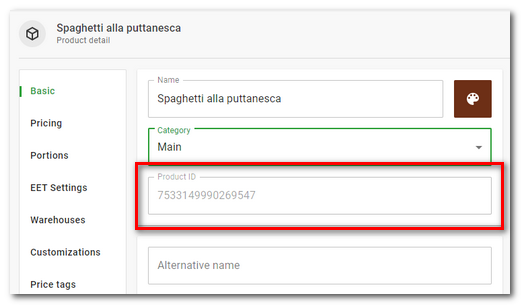 |
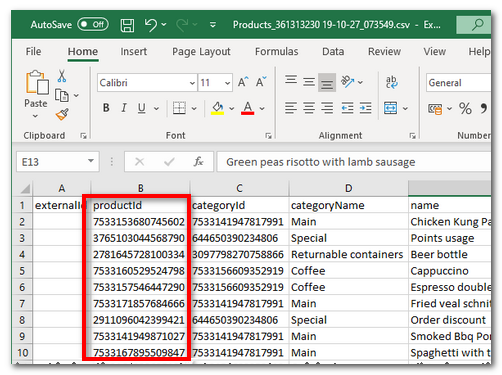 |
|
Log into Dotypos Cloud and go to Reports » Original reports |
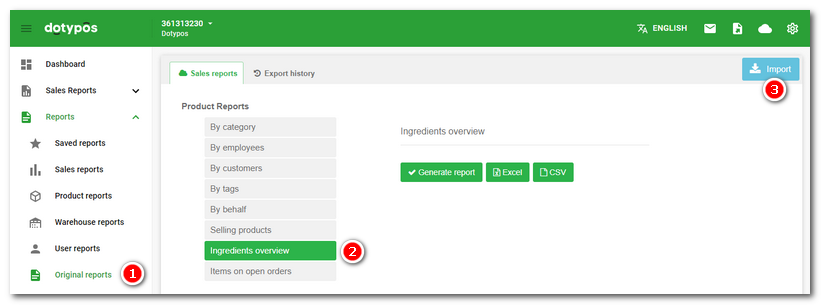
|
A page for inserting the import file and uploading it opens. The following procedure is identical to performing a batch import of other items. You can find a sample procedure for importing in this chapter. A detailed description of the file for importing ingredients can be found below. The upper part of the page is for importing, and the bottom part with warehouse selection is for generating the ingredients report. |
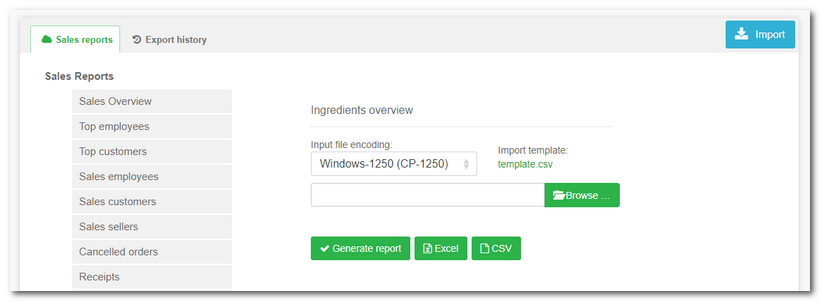
Description of import file columns
Ingredients import file |
|
parentExtId |
Unique number of a previously created product. By using this number, the cash register recognizes the ingredient product. However this marking by the customer is optional. For unique identification, we recommend to rather use the parentProductId, because this number is generated automatically by the POS system and you can find it for each product.
The easiest way to find out the number of the created product to be entered into this column is to export current products from the cash register or look into product properties at External label. |
parentProductId |
The unique number of a previously created product, generated automatically by the system. By using this number, the cash register recognizes the ingredient product.
The easiest way to find out the number of the created product to be entered into this column is to export current products from the cash register or look into product properties on the Product number. |
parentName |
Name of sold product. This name will represent the ingredient product in the cash register. |
ingredienceExtId |
Unique number of a previously created product that will be used as ingredients. You can add more ingredients to one product. Just create new records (rows) with the identical number of the product ingredienceExtId. Each row represents one ingredient. ingredienceExtId = External label |
ingredienceProductId |
Unique number of a previously created product that will be used as ingredients. You can add more ingredients to one product. Just create new records (rows) with the identical number of the product ingredienceProductId. Each row represents one ingredient. ingredienceProductId = Product number |
ingredienceName |
Ingredient name |
quantity |
Ingredient quantity (e.g. 0.5) |
units |
The unit of the ingredient (e.g. liter; an overview of applicable units can be found here). |
deleted |
Number identifying a deleted ingredient product (1 or 0 - deleted / non-deleted). Once a product has been deleted, it no longer appears on the cash register. The default value is 0. |
The required items are in the first column of the table and they are marked in bold, while the other items in the first column are optional.
|
Are supported .csv files with delimiter ; (semicolon) and , (comma). If semicolon is used, it is possible to separate decimal places by commas and periods. If you use a comma as a data separator, you must use a period to separate the decimal places. |
Sample of a correctly prepared file for importing ingredients
In the picture below, there is a sample of a file for import with two products for ingredients - Kofola and Café Latté. Café Latté consists of two ingredients - coffee and milk. The file does not have to contain the names of the products and ingredients (not obligatory items), because they are uniquely defined by their numbers.
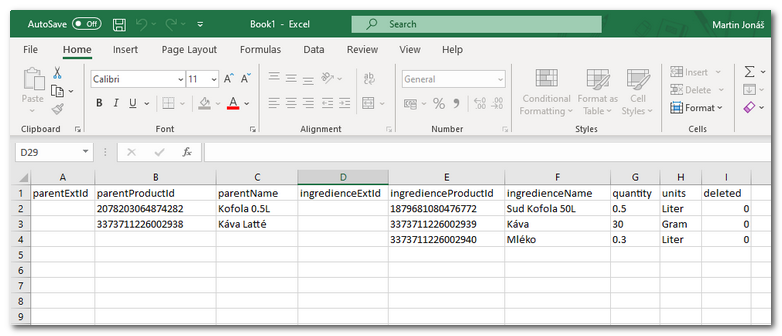
|
Remember that products with ingredients should not be stocked outside of the warehouse. On the other hand, in cash registers the ingredients should be hidden so the crew cannot charge them separately. Now, check whether you have correctly set up products used for the import of ingredients. |
 . On the right-hand side, select the report
. On the right-hand side, select the report  . After selecting this report, click on the button
. After selecting this report, click on the button in the top right corner.
in the top right corner.